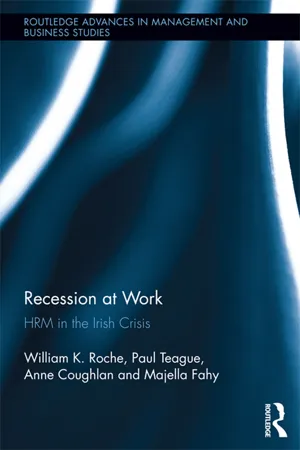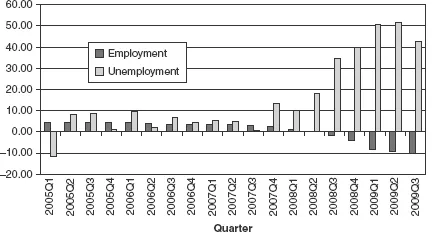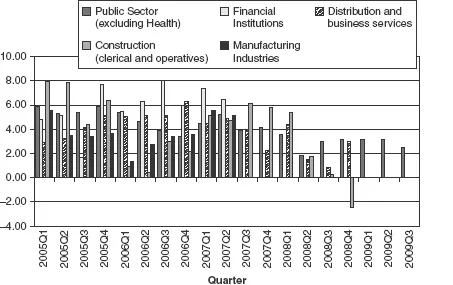![]()
1 Introduction
Ireland is in the grip of the most serious economic recession in its modern history, which is having profound effects on the labor market and on the management of human resources. Trade unions charged with defending their members’ pay and employment security face challenges without precedent in living memory. Other European countries affected by the financial, fiscal and economic crisis face pressures similar to Ireland's, but the Irish recession is among the most acute of all developed economies. The effects of the Irish recession on the manner in which people are managed at work and on how they are represented by trade unions is the subject of this study.
The context for this investigation is set out in Chapter 3. The impact of the international financial and economic crisis on the Irish labor market is assessed. Then, the Irish economic crisis is placed in a comparative European context to get a sense of the extent to which the response in Ireland has been similar to those pursued by other European Union (EU) member states. After this assessment a detailed review is conducted of the international literature and debates concerning the impact of recessions, past and current, on the conduct of human resources in organizations. This is followed by a detailed examination of the type of policies and practices available to organizations when making adjustments to difficult business conditions.
Chapter 3 sets out the findings of a survey of managers responsible for human resources. The survey examines the impact of the recession on changes in revenue and employment in firms to establish the commercial context for HR measures adopted. The chapter then goes on to examine the types and incidence of measures taken by firms, ranging from pay and headcount adjustments, to changes in working time arrangements and measures undertaken to preserve motivation and commitment. In addition to examining the range of individual measures adopted by firms, the manner in which firms combined these measures is also analyzed, as are the postures adopted by unionized firms in their dealings with unions during the recession. This is followed by an investigation into the role of the HR function in the recession. This investigation explores whether the work of HR functions and those who work within them has changed as a result of the recession, the function's influence on strategy formulation and implementation and the business role of HR. Finally, the chapter investigates the HR practices that survey respondents considered to be most effective in helping them manage the recession.
The findings of a series of focus groups with HR managers and trade union officials are outlined in Chapter 4, 5 and 6, and these cast a deeper light on the nature of the challenges arising and the responses adopted in the recession. Chapter 4 examines the effects of the recession as experienced by thirty HR managers representing a wide range of businesses. It reviews in detail the effects of acute cost, headcount and productivity pressures and the range of retrenchment measures that they were required to put in place. The chapter that follows examines HR managers’ understanding of what constitutes ‘good human resource practice’ in recessionary conditions.
Chapter 6 presents the views and experiences of 17 union officials participating in union focus groups. The officials represented employees working in the private, commercial semistate sectors and, in some instances, the public sector. The chapter first looks at union officials’ views on the effects of the recession on both their relationship with employers and with their own members. A significant element of their response was the negative change they perceived in the relationship between employers and unions. Following on from this is a discussion on their experience of collective bargaining in the recession. The union officials then give their viewpoint as to the features of good HR practice and the drivers of that good practice.
Chapter 7 and 8 present a series of six case studies that examine the responses of companies and unions to the pressures unleashed by the recession. The series of cases examined are regarded as instances of good practice in responding to different sets of recessionary pressures, and contain some significant innovative features. They were chosen because their responses to the recession are widely admired by their professional peers, because they had sought to accommodate employees’ interests in responding to the recession and because the parties to employment relations succeeded in all cases in securing or strengthening the businesses affected by reaching different forms of accommodation that commonly involving significant changes to the operation of businesses, to terms and conditions of employment and to work practices.
Chapter 7 outlines the rationale for case study selection in detail before proceeding to the examination of the first three cases. The three cases involved the introduction of measures aimed at minimizing job losses. The first case study in Irish Life and Permanent (IL&P) charts the ebb and flow of efforts in IL&P to adjust to the onset of the financial crisis in Ireland, culminating in measures that included incentivized career breaks, a voluntary redundancy program, agreed pay rises and the freezing of service-related increments. In responding to the crisis the firm sought to institute new arrangements for the conduct of industrial relations with the trade unions representing its employees, operate through a unitary HR function (then in the process of being created), and win agreement on a series of cost-saving measures.
The second case study examines how Sherry Fitzgerald (operating in a sector almost devastated in the recession) developed its response to the recession when faced with the imperative to significantly cut costs, while at the same time deciding that its chief HR priority would involve employment protection and job security. Following the strategy adopted, Sherry Fitzgerald has managed to retain its position and brand identity in the industry in a period of severe and unprecedented contraction and has preserved and reinforced its culture.
Again, operating in a sector on which the recession has had a severe impact, the final case study in this section deals with the agreement reached between the Dublin Airport Authority (DAA) and the unions representing staff, on the Cost Recovery Programme and the innovative Employee Recovery Investment Contribution (ERIC) proposal. These agreements compose an innovative initiative in which management and unions, working mainly through traditional IR postures and processes, succeeded in reaching an accord that secured the viability of the company and that also provided for the restoration of pay levels once the DAA returned to profitability.
Superquinn, Medtronic and Ericsson were the subjects of the case studies in the next chapter and had to deal with different problems brought on by the recession. Superquinn struggled for its very survival, whereas Medtronic was actively engaged in defending its mandate within the multinational of which it was a subsidiary. Ericsson has sought to preserve competency development as a core HR practice while adapting to the recession by implementing redundancies at its Irish operations. The case studies chart the paths taken by the three firms to maintain and deepen cooperation and trust between management, employees and unions and to retain core HR practices while adjusting to the recession. The two key components of Superquinn's strategy were a negotiated survival plan agreement, which provided for the introduction of cost-cutting initiatives, such as redundancies and a pay freeze, and a new partnership-style procedural agreement. These agreements were essential to the survival of Superquinn in acute trading conditions.
The second case study follows the experience of Medtronic Galway (the only unionized subsidiary in this US multinational) through the recession, from the time its head office decided it needed to take action to improve profitability and cost competitiveness to the agreement reached with the trade union. It shows how the organization, despite having to renege on an agreement with unions that had been difficult to negotiate, still managed to face adverse business relations without jeopardizing trust relations. In reaching agreement, management and unions adopted a central principle of interest-based bargaining, which is to recognize and take on board the constraints of the other negotiating side. The final case study in the chapter examines Ericsson's retention of competency development as a core HR practice, while the company's Irish operations simultaneously maintained competitiveness. Significant job losses resulted but the company was still seen as possessing highly skilled and motivated people.
The final chapter addresses a number of major findings from the study in the context of the international literature. Discussion covers HR retrenchment programs, the role of the HR function, the effects of the recession on union representation and the effects of the recession on work and employment arrangements. The chapter ends with a discussion of the international import of Ireland's experience during the recession.
![]()
2 Recession, the Labor Market and the Conduct of Human Resource Management
2.1 INTRODUCTION
Ireland's employment growth in the 1990s was nothing less than spectacular. In less than a decade, a million new jobs were created, doubling the size of the labor market. If that much-abused term Celtic Tiger has any applicability, it is in relation to this hugely impressive job generation performance (Honahan 2006). Even in the first part of the noughties, employment creation was higher than most other EU member states, although the fact that 80% of the jobs created were in the construction industry should have caused some alarm bells to ring. But this exceptional employment performance came to a shuttering halt in the wake of the world financial crisis that started in 2007. It became apparent very quickly that Ireland was in the eye of this financial storm as its banks had become overexposed to bad debt due to profligate leading to property developers (Whelan 2010). Turbulence in the financial markets soon spread to other parts of the economy as consumer demand dried up and business confidence evaporated. The government has found itself in the position of needing to squeeze the public sector in an endeavor to stabilize the financial sector and public finances. Within a year, unemployment had increased to about 12.5% and job generation had ground to a virtual halt (Bergin et al 2010). The exuberance of the vingt glorieuses has been pushed aside as the gloom and doom of previous decades reappeared.
For companies in Ireland the financial crisis was a huge asymmetric shock. In the 10-year period up to about 2005, companies continuously struggled to fill vacancies. Recruiting and retaining staff preoccupied human resource departments almost everywhere. In an effort to help satisfy this big demand for labor, government, in an ironical historical twist, actively promoted employment migration. For example, in 1999, 6,000 work permits were issued to foreign nationals, a figure which jumped subsequently to 48,000 in 2003. Between 2000 and 2005 in excess of 100,000 non-European Economic Area (EEA) nationals alongside 50,000 EU citizens had taken up employment in the country. After the financial crash, the business environment changed completely. Large numbers of companies stopped hiring people while others, facing harsher economic times, began the process of shedding labor. Many human resource managers now face the challenging task of devising policies that would allow firms adjust to adverse market conditions in the short term without disrupting the potential to innovate and grow in the long term.
The main focus of this study is to assess the extent to which human resource managers have successfully faced this challenge by working closely with employees and unions, where they are found, and by pursuing policies that allow short-term cost pressures to be addressed without threatening the organizational conditions required for long-term business success. The purpose of this chapter is to set the context for this investigation. First of all, the impact of the international financial crisis on the Irish labor market is assessed. Then, the Irish economic crisis is placed in a comparative European context to get a sense of the extent to which the public policy response in Ireland has been similar to those pursued by other EU member states. After this assessment a detailed literature review is conducted on the impact of recessions, past and present, on the conduct and performance of human resources in organizations. The following section examines in detail the type of policies and practices that are available to HR when making adjustments to difficult business times. The penultimate section provides a snapshot, based on the data available, of the type of policies that firms have been implementing in Ireland since the onset of the financial crisis in 2007. The Conclusion section brings together the arguments of the chapter.
2.2 THE WORLD FINANCIAL CRISIS AND THE IRISH LABOR MARKET
The recent world financial crisis has had a hugely negative impact on economies, although some have been affected more adversely than have others. Ireland was among those worst hit by the crisis mainly as a result of the way the economy operated between 2000 and 2007. During this time bank credit expanded rapidly. The availability of easy money encouraged a boom in construction activity and property prices, which in turn fuelled domestic spending more widely (Honahan 2006). This cycle of unsustainable growth not only came to a halt, but also went into reverse when financial markets crashed. Almost overnight bank credit ceased up, construction activity came to a virtual stop and domestic demand plummeted. The resulting contraction in the economy has been severe and unprecedented. Banks have been brought to the edge of collapse due to a mountain of bad debts. The government has been forced into a big fiscal consolidation program in an effort to repair the deterioration in public finances, culminating in the EU/International Monetary Fund (IMF) loans and the four-year austerity program of November 2010. All in all, the economy has been shrinking and prices falling and unemployment rising, the classic symptoms of a country in recessionary times. Moreover, all indicators suggest that it will be some time before the return to normal functioning of the economic system.
Figure 2.1 Employment and unemployment in Ireland
Source: CSO Labour Market Statistics 2010
Labor market activity has experienced the full ravages of the downturn. Employment and unemployment trends are immediate and reliable indicators of labor market performance. Figure 2.1 shows that the recession has had a huge negative impact on the Irish labor market. On one hand, net employment growth has been negative, with more jobs being lost than being created: in 2007 there were 2.1 million people in jobs, but by 2009 this had fallen to 1.9 million. On the other hand, there have been big annual percentage increases in unemployment: in 2007 the unemployment rate stood at 4.4%, but by 2009 it had increased to 12.5%. Toward the end of 2010 the level of unemployment stands at 13.6%. Thus, the virtuous era of employment growth has come to an end. For the most part, companies seem to have responded to bad economic times by reducing factor quantities (employment), but they have also moved to adjust factor prices (wages). It is difficult to get comprehensive, up-to-date figures with regard to earnings, but Figure 2.2 provides the information that is available from official statistics. Later in the chapter, other indicators of trends in pay and pay bargaining are reviewed. Three noteworthy points emerge from the figure. First, employees, across the board, enjoyed yearly healthy increases in wages during the early 2000s. Second, wages have declined quite sharply in the construction sector since 2007, which is hardly surprising given the steep slump in business activity in this part of the economy. Third, although the picture varies from sector to sector, an economy-wide fall in wages in response to the recessions appears not to have occurred from 2007 through 2009—some sectors even recorded small increases during this period. To some extent, this trend should not be surprising as real wages are relatively rigid downward. But this picture can change if the effect of deep recession will be to force prices down in all sorts of markets, including labor markets. Thus, it is instructive to note that the Central statistics Office (CSO) in late 2010 reported a modest decline (of 0.2%) in hourly earnings in the private sector over the 12 months to the third quarter of 2010.
Figure 2.2 Average earnings growth by sector
Source: CSO Earnings Statistics 2010
Unemployment has affected some groups and sectors more than it has others. Men are losing their jobs at a much faster rate than are women: from 2008 onward the fall in overall male employment has been running at three times the rate of the fall in female employment. Moreover, in 2009 whereas the unemployment rate for females was approximately 8.5%, male unemployment was pushing 16.0%. Young people have been hit hardest by the economic downturn. In 2007, the unemployment rate for 15- to 19-year-olds was just over 16.0%, but in two years it had leaped to nearly 35%. The picture for the 20- to 24-year-olds is only slightly better: in 2007, unemployment for this group was just over 8%, but by 2009 it had jumped by a factor of three to around 24%. These grim figures threaten the return of the bad old days when young people thought that Ireland offered them no hope or opportunities and as a result emigrated in search of a better life elsewhere.
Unsurprisingly, the construction sector has seen heavier job losses than other parts of the economy. Since 2007 some 72,000 jobs have been lost in the sector, a decline of nearly 30%. Other sectors have been affected too. Employment has declined by 12.3% in agriculture, which is surprising given the strong employment growth experienced by the sector earlier in the decade. Just over 6.0% of jobs were lost in the industrial sector, which although regrettable is not as bad as other sectors. Overall, the manufacturing sector remains relatively healthy as indicated by the continuing strong export performance of the Irish economy. The employment performance of the service sector has been mixed. Some parts of the public sector, most notably education and health, actually exper...


